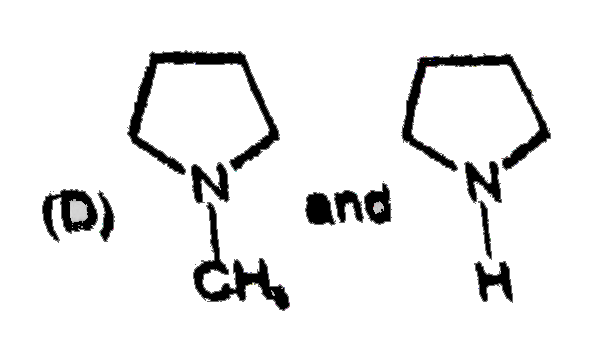In which case second has lower boiling point than first ?




The correct Answer is:A,B,C
To determine in which case the second compound has a lower boiling point than the first, we need to analyze the properties of the compounds based on their molecular structure and the presence of functional groups that influence boiling points, such as hydrogen bonding and dipole moments.
1. Analyze the First Case:
- The first compound has a three-membered ring with an OH group, while the second has a four-membered ring with one O atom.
- The presence of the OH group in the first compound allows for hydrogen bonding, which significantly raises its boiling point.
- Conclusion: The first compound has a higher boiling point than the second.
2. Analyze the Second Case:
- The first compound has an oxygen atom, while the second does not.
- The dipole moment in the first compound is directed due to the presence of the oxygen, while the second compound lacks this feature.
- The higher dipole moment in the first compound leads to stronger intermolecular forces, resulting in a higher boiling point.
- Conclusion: The first compound has a higher boiling point than the second.
3. Analyze the Third Case:
- The first compound has two OH groups, while the second has only one.
- The presence of two OH groups in the first compound allows for more hydrogen bonding, which increases its boiling point.
- Conclusion: The second compound has a lower boiling point than the first.
4. Analyze the Fourth Case:
- The first compound has nitrogen bonded to carbon, while the second has nitrogen bonded to hydrogen.
- The presence of hydrogen bonding in the second compound (due to nitrogen and hydrogen) increases its boiling point.
- Conclusion: The second compound has a higher boiling point than the first.
Final Answer:
The cases in which the second compound has a lower boiling point than the first are:
- Case 1 (first compound has OH group leading to hydrogen bonding)
- Case 2 (first compound has a higher dipole moment)
- Case 3 (first compound has two OH groups)
Thus, the correct options are Case 1, Case 2, and Case 3.
- The first compound has a three-membered ring with an OH group, while the second has a four-membered ring with one O atom.
- The presence of the OH group in the first compound allows for hydrogen bonding, which significantly raises its boiling point.
- Conclusion: The first compound has a higher boiling point than the second.
- The first compound has an oxygen atom, while the second does not.
- The dipole moment in the first compound is directed due to the presence of the oxygen, while the second compound lacks this feature.
- The higher dipole moment in the first compound leads to stronger intermolecular forces, resulting in a higher boiling point.
- Conclusion: The first compound has a higher boiling point than the second.
- The first compound has two OH groups, while the second has only one.
- The presence of two OH groups in the first compound allows for more hydrogen bonding, which increases its boiling point.
- Conclusion: The second compound has a lower boiling point than the first.
- The first compound has nitrogen bonded to carbon, while the second has nitrogen bonded to hydrogen.
- The presence of hydrogen bonding in the second compound (due to nitrogen and hydrogen) increases its boiling point.
- Conclusion: The second compound has a higher boiling point than the first.
The cases in which the second compound has a lower boiling point than the first are:
- Case 1 (first compound has OH group leading to hydrogen bonding)
- Case 2 (first compound has a higher dipole moment)
- Case 3 (first compound has two OH groups)
Topper's Solved these Questions
Similar Questions
Knowledge Check
In the given pair of compounds, in which pair second compound has higher boiling point than first compound ?
A B
B CHO−CH2−CH2−OHandCH3−CH2−CH2−OHD
CHO−CH2−CH2−OHandCH3−CH2−CH2−OHD
Among the given pairs in which pair, first compound has higher boiling point than second ?
ACH3−CH2OCH3andCH3−CH∣OH−CH3BCH3−CH2−CH2−CH3andCH3−CH2−CH3CCH3−CH2−CH2−CH2−CH3andCH3−CH2−CH3∣CH−CH2−OHDCH3−CH2−CH2−CH3andCH3−CH2−CH2−Cl
Which has the lowest boiling point?
View SolutionWhich one has the highest boiling point?
View SolutionStatement-1:Branched alkanes have lower boiling point than their unbranched isomers
Statement-2: Branched alkanes has relatively small surface area, so less London's dispersion force act among molecules.
View SolutionA …......... chain alkane has usually a lower boiling point than corresponding …......... Chain alkane.
View Solutionp-Hydroxybenzoic acid has a lower boiling point than o-hydroxybenzoic acid.
o-Hydorxybenzoic acid has intramolecular hydrogen bonding.
View SolutionPH3 has lower boiling point that NH3. Why ?
View Solution

